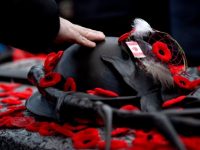Twenty Things You Must Know About The Canadian Flag

From the Maritimes to the Rockies, this Canada Day is “show your heritage pride season.” From coast to coast, the summer season is also flag season. Have you noticed them in your neighbourhood, at work, or at your child’s soccer game?
On July 1, Canada day, many of us will go to our garages, attics or basements, and will take out our national flag to testify our allegiance to our country.
What you should know about the National Flag of Canada (its official name):
1. Proclaimed by Her Majesty Queen Elizabeth II, it is on February 15 1965, during a Parliament Hill ceremony, that the single 11 points maple leaf design was officially inaugurated.
2. Flag etiquette is not legislated. It is simply a question of respect. Flags are the utmost symbols of patriotism. They signify honour, pride and unity no matter what your origins are, what language you speak, what your values are and for whom you voted.
3. Monday to Friday, weather permitting and on non-statutory holidays, a technically trained employee changes the Peace Tower flag, in a 20 to 30 minute process.
Flag guidelines and respectful practices
4. The National Flag should dominate the space where it is displayed. Trees, lampposts or buildings, should not shadow it.
5. Flags that are not in good condition should not be displayed. Worn out, frayed, faded or ripped flags should be disposed of with dignity. A private burning is recommended.
6. In our country, the National Flag takes precedence over all other national flags. Protocol dictates that it should be on its own mast, not paired with another flag.
7. Covering a statue, a work of art or other objects with the Canadian flag is discouraged. Even on the Stanley Cup, when a Canadian team wins it.
8. A flag should not be used as a decoration. It should not be draped, made into a flower, used as a tablecloth, seat cover, shawl or to cover a lectern.
9. Nothing should be attached, pinned or sewn to it. It is also inappropriate to mark or write on it. This would also include signatures of prominent Canadians.
How to display your flag
10. Generally, the Canadian flag may be flown 24 hours a day.
11. Hanging horizontally: on a wall, a fence, in a window or from a mast or pole, from an observer’s point of view, the point of the leaf is always at the top and the bottom of the stem is at the base.
12. Hanging vertically: from an observer’s point of view, the tip of the maple leaf is to the left and the stem is to the right.
13. On a boat: When in harbour, it is to be flown from 0800 to sunset, usually at the stern.
14. On a car: it is secured to a firm pole and displayed on the right chassis.
15. On a podium: from the observer’s point of view, it should be to the speaker’s left.
16. In a parade: when marching single file, in our country, the National Flag of Canada will lead the others.
17. On a lapel: it should be worn on the left.
18. On a backpack: we, and the rest of the world know of the value of this Canadian symbol, eh! More than “I am Canadian’,” it says what we are not. Display it with pride and keep it looking dignified.
Saluting the flag
19. When a flag is raised, lowered, or when it passes by in a parade, men should remove their hats and we should all remain silent. Uniformed personnel will salute the flag accordingly with their hand.
Getting a flag
20. Don’t have a Canadian flag yet? Get one for free, by adding your name to the waiting list. Be prepared to wait though. The expected delay for your flag delivery is now up to 38 years for a Peace tower flag. If you want to diminish your wait time by 13 years, order an East or West block block flag.
Happy Canada Day!
Published June 20th, 2013 Huffington Post (c) Julie Blais Comeau




